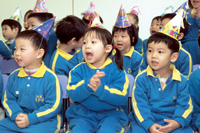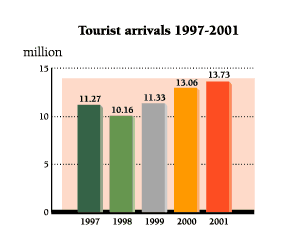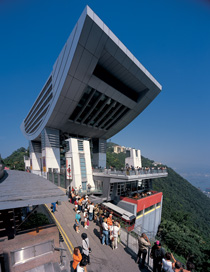- Early childhood education

(upgrading qualifications of kindergarten teachers);
- Curriculum development (providing teachers with greater flexibility
to provide students with a comprehensive and balanced learning experience
covering intellectual development, life skills, community services,
work-related experiences, as well as physical and aesthetic development)
- School place allocation systems (reducing the incentive for unhealthy
drilling in early childhood and primary education).
- Strengthening remedial and enhancement measures (helping all students
to obtain basic standards, or talented students to pursue excellence).
- Public examinations (placing more emphasis on students' higher-order
thinking skills and setting clearer assessment standards).
- Enhanced learning opportunities (increasing subsidised Secondary 4
and 5 places for those willing and able to continue studies).
- Increased resources for teaching English and Chinese, including Putonghua
(introduce native English-speaking teachers and making Putonghua a core
subject in secondary and primary schools, raising the language proficiency
of English and Putonghua teachers).
- Upgrading the quality of teachers (percentage of trained teachers
in public sector schools increased from 85% in 1997 to 91% in 2001).
Attracting talent
Hong Kong's liberal immigration regime has made it reasonably easy to attract and retain talented people from around the world. About 300 000 expat business people, professionals, personnel and their families live in Hong Kong.
However, more is being done in a number of areas:
- Reviewing immigration policy with a view to relaxing restrictions
on the entry of overseas investors who wish to invest and live in Hong
Kong without engaging in the running of the business.
- Securing agreement with Mainland authorities to extend the validity
period of multiple business visit endorsements for Mainland business
people from six months to up to three years, and extend the duration
of stay to 14 days.
- Accelerating the entry to Hong Kong of Mainland people with skills
or qualifications needed to help Hong Kong's ongoing development through
an Admission of Talents Scheme and an Admission of Mainland Professionals
Scheme.
- Making it easier for foreign nationals living in Hong Kong to visit
the Mainland. The HKSAR Government secured the agreement of the Mainland
authorities to issue three-year, multiple-entry visas to Hong Kong permanent
residents who are foreign nationals. The new measures were introduced
in December 2001.
Despite two economic downturns in the past four years, and a global slowdown in tourist traffic after the September 11, 2001 terrorist attacks in the United States, Hong Kong's tourism industry has continued to record impressive growth.
This growth has been fuelled by increasing numbers of visitors from the Mainland, and greater promotion of Hong Kong's attractions in other key markets.
The scrapping of a quota system for Mainland tour groups in January 2002 has provided a great boost to arrivals from across the boundary, as well as a fillip to tourism-related businesses such as hotels, restaurants and bars and retailers.
However, competition for visitors throughout the region is fierce and Hong Kong has been continually upgrading its tourism product to meet future challenges.
Part of the strategy has been to promote Hong Kong as a top-class destination for leisure and business visitors. This involves providing additional infrastructure, improving existing facilities, enhancing service quality, facilitating entry of visitors and active promotion overseas. In the past few years, new attractions have been announced to enhance the drawing power of Hong Kong and to sustain the long-term development of the tourism industry.
In December 1999, a deal was signed with The Walt Disney Company to bring the magic of Disney to Hong Kong.
Reclamation work on the site at Penny's Bay on Lantau Island started in mid-2000 and is more than 90% complete. Infrastructure works commenced in October 2001.
Hong Kong Disneyland Phase 1 will include a Disney theme park, Disney-themed hotels and retail, dining and entertainment facilities. It will occupy 126 hectares, and can be expanded to 180 hectares in the future. Phase 1 is expected to open in 2005.
The project involves a total commitment of HK$22 billion (US$2.8 billion) in public funds (infrastructure, loans and equity). In its first full year of operation, Hong Kong Disneyland is expected to attract over 5 million visitors, including 1.4 million new tourists, and stimulate additional spending of HK$8.3 billion (US$1.1 billion). Over a 40-year period it is expected to generate economic benefits amounting to HK$148 billion (US$19 billion).
Many other projects are also in the pipeline. Plans were announced in 2001 to implement five major tourism clusters to broaden the range of tourist facilities in Hong Kong. These will be developed in the medium to long term:
- Yam O on Lantau Island will be developed into a new tourism node. This, together with Hong Kong Disneyland, the Tung Chung Cable Car and the Big Buddha will make Lantau Island a truly spectacular tourism area.
- The beautiful countryside and peaceful harbour at Sai Kung in the eastern New Territories will be carefully and sensitively developed to provide a range of active recreational facilities such as hiking and water sports together with world-class resorts.
- A culture belt will be developed to stretch from a new integrated arts, culture and entertainment district on the West Kowloon Reclamation to the existing museums and performing arts venues in Tsim Sha Tsui, the former Marine Police Headquarters and the Tsim Sha Tsui Promenade. A new tourism node will be developed at south-east Kowloon incorporating a large-scale multi-purpose stadium and a new cruise terminal capable of meeting the needs of the new generation of mega cruise ships.
- A heritage, entertainment and dining area will be developed in the heart of Central, radiating from the site of the existing Central Police Station and covering attractions like Government House, St John's Cathedral, Hollywood Road and Lan Kwai Fong.
- Ocean Park's strategic development plan will be supported to help it integrate into the new Aberdeen Harbour tourism node.
Apart from this, a major eco-tourism facility, the Hong Kong Wetland Park project is being developed near Inner Deep Bay/Mai Po in the far northwest of Hong Kong. This will showcase Hong Kong's ecological richness and complement the internationally recognised wildlife conservation area in the adjacent Mai Po Marshes. The project is due for completion in 2005.
Action is also in hand to improve existing tourist attractions and facilities. Since 2000, a district-based tourist enhancement programme was launched to upgrade existing tourist attractions. Visitors' signage covering all 18 districts is being installed and will be completed in 2003.
To promote quality service among the retail and catering sector, the Hong Kong Tourism Board (a statutory body responsible for marketing and promoting Hong Kong as a tourist destination) launched the Quality Tourism Service Scheme (QTS) in 1999. So far, more than 860 retail and food premises have joined the scheme with more than 2 900 outlets now eligible to display the QTS logo as a sign of their adherence to high service standards.
A public education campaign was launched in 2001 to promote a hospitable culture in the community. New legislation has been passed to regulate inbound travel agents and the trade will implement a training and certification programme for tour guides to ensure they have the appropriate skills.
- Yam O on Lantau Island will be developed into a new tourism node. This, together with Hong Kong Disneyland, the Tung Chung Cable Car and the Big Buddha will make Lantau Island a truly spectacular tourism area.
Whatever Hong Kong's aspirations, they can not be met without a broad, deep pool of talented people.
This can be achieved by providing a world-class education system in Hong Kong, and by attracting the best and the brightest from all parts of the world to live and work in Hong Kong.
A series of new education initiatives have been launched over the past five years to enhance the quality of education.
The focus has been to move away from the learning-by-rote system to one that provides children with a more well-rounded education that encourages curiosity and nurtures their own particular strengths and interests.
Considerable resources have also been committed to encourage Hong Kong people to continue learning throughout their lives. In his 2001 Policy Address, the Chief Executive, Mr Tung Chee Hwa, announced the establishment of a HK$5 billion (US$640 million) Continuing Education Fund to subsidise those with learning aspirations to pursue continuing education and training programmes.
There have been reforms and significant improvements in the areas
of: